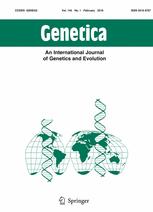Ver ítem
- xmlui.general.dspace_homeCentros Regionales y EEAsCentro Regional Salta - JujuyEEA Abra PampaArtículos científicosxmlui.ArtifactBrowser.ItemViewer.trail
- Inicio
- Centros Regionales y EEAs
- Centro Regional Salta - Jujuy
- EEA Abra Pampa
- Artículos científicos
- Ver ítem
Genetic diversity and conservation status of managed vicuña (Vicugna vicugna) populations in Argentina
Resumen
The vicuña (Vicugna vicugna) was indiscriminately hunted for more than 400 years and, by the end of 1960s, it was seriously endangered. At that time, a captive breeding program was initiated in Argentina by the National Institute of Agricultural Technology (INTA) with the aim of preserving the species. Nowadays, vicuñas are managed in captivity and in the wild to obtain their valuable fiber. The current genetic status of Argentinean vicuña populations is
[ver mas...]
The vicuña (Vicugna vicugna) was indiscriminately hunted for more than 400 years and, by the end of 1960s, it was seriously endangered. At that time, a captive breeding program was initiated in Argentina by the National Institute of Agricultural Technology (INTA) with the aim of preserving the species. Nowadays, vicuñas are managed in captivity and in the wild to obtain their valuable fiber. The current genetic status of Argentinean vicuña populations is virtually unknown. Using mitochondrial DNA and microsatellite markers, we assessed levels of genetic diversity of vicuña populations managed in the wild and compared it with a captive population from INTA. Furthermore, we examined levels of genetic structure and evidence for historical bottlenecks. Overall, all populations revealed high genetic variability with no signs of inbreeding. Levels of genetic diversity between captive and wild populations were not significantly different, although the captive population showed the lowest estimates of allelic richness, number of mitochondrial haplotypes, and haplotype diversity. Significant genetic differentiation at microsatellite markers was found between free-living populations from Jujuy and Catamarca provinces. Moreover, microsatellite data also revealed genetic structure within the Catamarca management area. Genetic signatures of past bottlenecks were detected in wild populations by the Garza Williamson test. Results from this study are discussed in relation to the conservation and management of the species.
[Cerrar]

Autor
Anello, Melina;
Daverio, Maria Silvana;
Romero, Sandra Raquel;
Rigalt, Francisco Antonio;
Silbestro, Miriam Beatriz;
Vidal Rioja, Lidia Beatriz;
Di Rocco, Florencia;
Fuente
Genetica 144 (1) : 85–97. (February 2016)
Fecha
2016-02
ISSN
0016-6707 (Print)
1573-6857 (Online)
1573-6857 (Online)
Formato
pdf
Tipo de documento
artículo
Palabras Claves
Derechos de acceso
Restringido
 Excepto donde se diga explicitamente, este item se publica bajo la siguiente descripción: Creative Commons Attribution-NonCommercial-ShareAlike 2.5 Unported (CC BY-NC-SA 2.5)
Excepto donde se diga explicitamente, este item se publica bajo la siguiente descripción: Creative Commons Attribution-NonCommercial-ShareAlike 2.5 Unported (CC BY-NC-SA 2.5)

